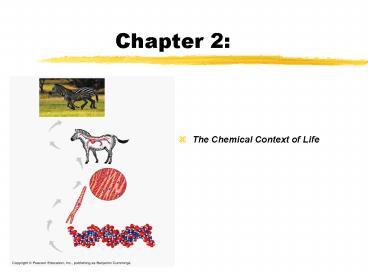The Chemical Context of Life - PowerPoint PPT Presentation
1 / 18
Title:
The Chemical Context of Life
Description:
Title: Lecture #1 ~ Date_____ Author: Chris Hilvert Last modified by: bmorton Created Date: 8/29/2000 1:04:40 PM Document presentation format – PowerPoint PPT presentation
Number of Views:139
Avg rating:3.0/5.0
Title: The Chemical Context of Life
1
Chapter 2
- The Chemical Context of Life
2
Why are we studying chemistry?
- Chemistry is the foundation of Biology
3
Chemical Context of Life
- Matter (space mass)
- Element compound
- The atom
- Atomic number ( of protons) mass number
(protons neutrons) - Isotopes (different of neutrons) radioactive
isotopes (nuclear decay) - Energy (ability to do work) energy levels
(electron states of potential energy)
4
- Everything is made of matter
- Matter is made of atoms
Hydrogen 1 proton 1 electron
Oxygen 8 protons 8 neutrons 8 electrons
Proton
Neutron
Electron
0
5
The World of Elements
H
C
O
N
P
S
Na
Mg
K
Ca
Different kinds of atoms elements
6
Life requires 25 chemical elements
- About 25 elements are essential for life
- Four elements make up 96 of living matter
- carbon (C) hydrogen (H)
- oxygen (O) nitrogen (N)
- Four elements make up most of remaining 4
- phosphorus (P) calcium (Ca)
- sulfur (S) potassium (K)
7
Bonding properties
- Effect of electrons
- electrons determine chemical behavior of atom
- depends on numberof electrons in atoms
outermost shell - valence shell
How does this atom behave?
8
Whats themagic number?
Bonding properties
- Effect of electrons
- chemical behavior of an atom depends on number of
electrons in its valence shell
How does this atom behave?
How does this atom behave?
9
Elements their valence shells
Elements in the same row have the same number of
shells
Moving from left to right, each element has a
sequential addition of electrons ( protons)
10
Elements their valence shells
Elements in the same column have the same valence
similar chemical properties
Remember some food chainsare built on reducing
O to H2O some on reducing S to H2S
11
Chemical reactivity
- Atoms tend to
- complete a partially filled valence shell
- or
- empty a partially filled valence shell
This tendency drives chemical reactions
and creates bonds
12
Ionic bonding
- High electronegativity difference strips valence
electrons away from another atom - Electron transfer creates ions (charged atoms)
- Cation (positive ion) anion (negative ion)
- Ex Salts (sodium chloride)
13
Covalent Bonding
- Sharing pair of valence electrons
- Number of electrons required to complete an
atoms valence shell determines how many bonds
will form - Ex Hydrogen oxygen bonding in water methane
14
Nonpolar covalent bond
- Pair of electrons shared equally by 2 atoms
- example hydrocarbons CxHx
- methane (CH4 )
balanced, stable,good building block
15
Polar covalent bonds
- Pair of electrons shared unequally by 2 atoms
- example water H2O
- oxygen has stronger attraction for the
electrons than hydrogen - oxygen has higher electronegativity
- water is a polar molecule
- vs poles
- leads to many interesting properties of water
16
Hydrogen bonds
- Hydrogen atom covalently bonded to one
electronegative atom is also attracted to another
electronegative atom (oxygen or nitrogen)
17
Hydrogen bonding
- Polar water creates molecular attractions
- attraction between positive H in one H2O molecule
to negative O in another H2O - also can occur wherever an -OH exists in a
larger molecule - Weak bond
H
H
O
Lets go to the videotape!
18
van der Waals interactions
- Weak interactions between molecules or parts of
molecules that are brought about by localized
change fluctuations - Due to the fact that electrons are constantly in
motion and at any given instant, ever-changing
hot spots of negative or positive charge may
develop































